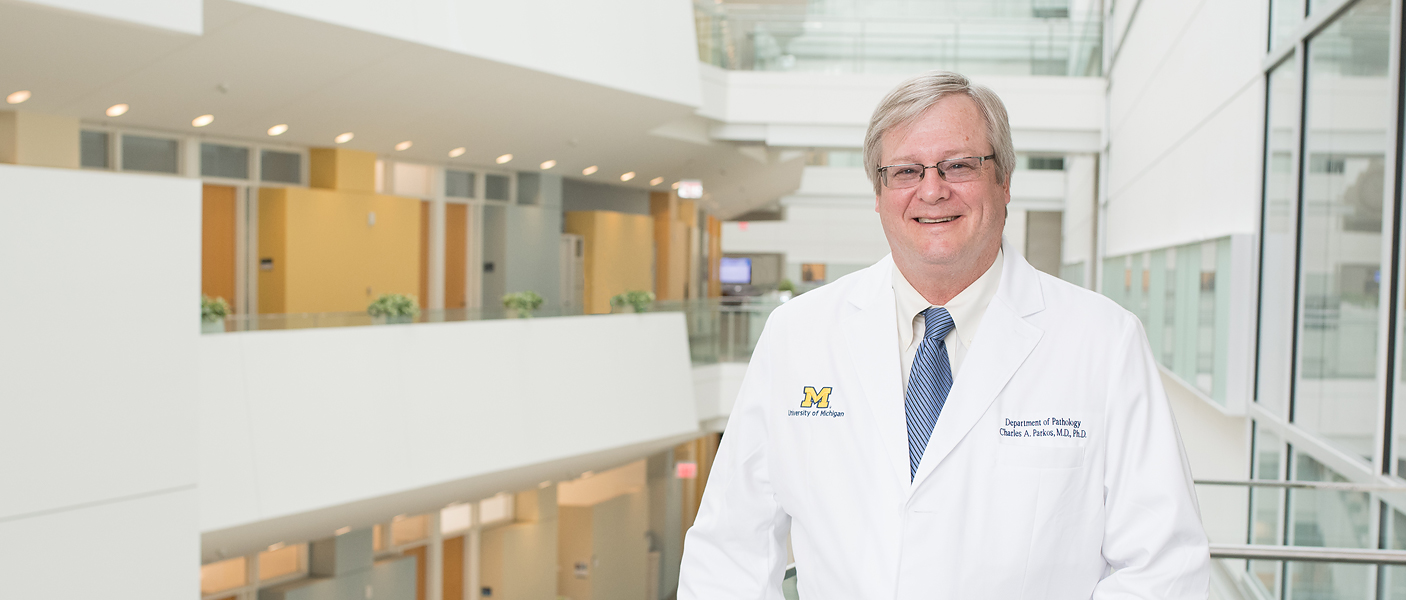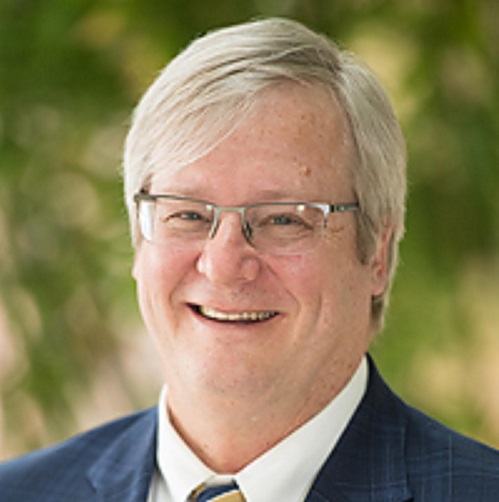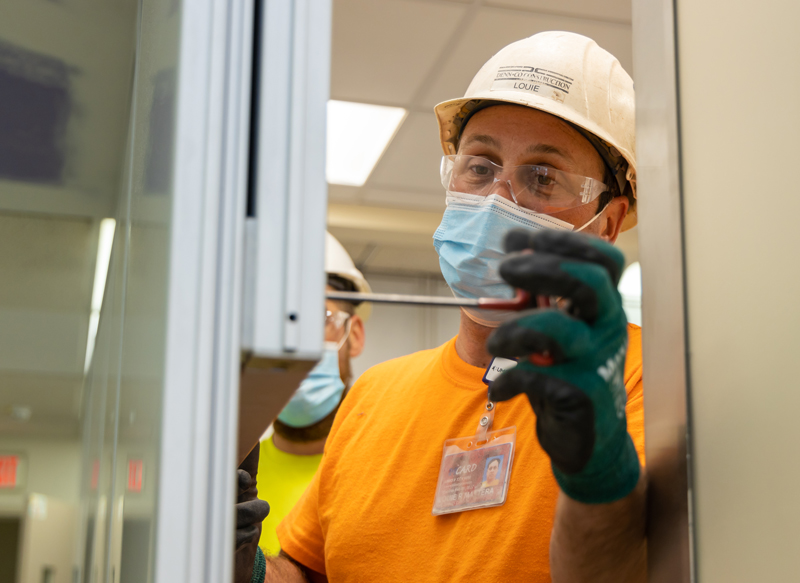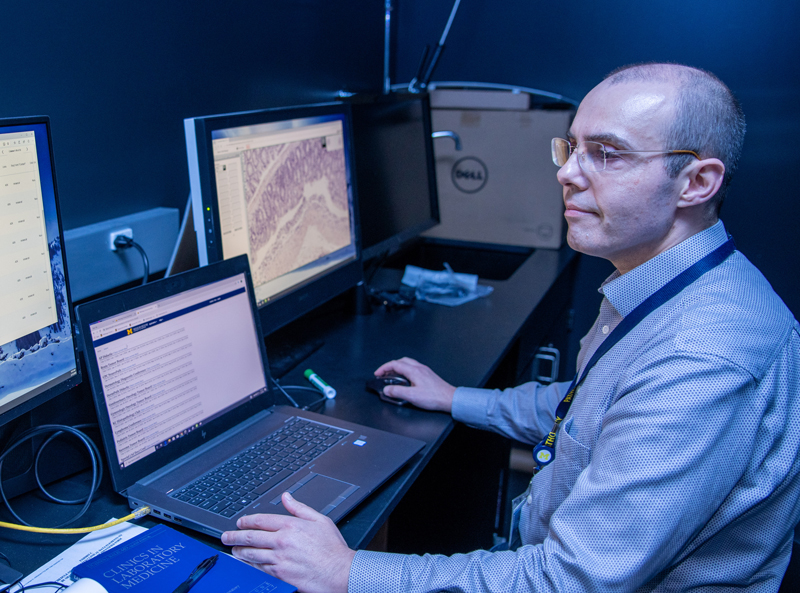

W
hen the field of Pathology comes to mind, many immediately think of autopsies and television shows on forensics and death investigation. This perception of what pathologists do represents both a challenge and an opportunity for the field, according to Dr. Charles A. Parkos, MD, PhD, Carl V. Weller Professor and Chair of Pathology at the University of Michigan. “Many students still think that pathologists just do autopsies, and that couldn’t be further from the truth,” states Parkos.
The number subspecialties in pathology is comparable to that in other fields of medicine. For those interested in clinical laboratory specialties, options include blood bank, chemistry, microbiology, toxicology, immunology, and molecular diagnostics, to name a few. Those interested in tissue-based pathology, termed anatomic pathology, can choose to focus on diseases of the skin, gastrointestinal tract, lung, breast, reproductive tract, blood system, forensics, and many others. To complement these subpecialized areas, there are innumerable opportunities in research, education, and information technology. There are even opportunities for those interested in direct hands-on patient care. Cytopathologists, for example, perform fine needle aspiration procedures targeting the thyroid, breast, and other tissues to aid in diagnoses of a variety of conditions. Abundant direct patient interactions also occur in apheresis and the blood bank. “These are patient encounters that have all the gratifying aspects to them that you would find in family practice, for example, or being a clinical internist. There are very broad and distinct possibilities that offer great career opportunities,” said Parkos. “The other underappreciated fact is that many of these specialties are very significantly undersubscribed, so there are excellent job opportunities.”
In the United States, misconception of the breadth of career opportunities has contributed to decreasing numbers of medical students applying for residency training in pathology. Given a growing number of pathologists nearing retirement age, a serious workforce shortage is looming. While the Department of Pathology at U-M is not immune from this challenge, “we have the capacity and resources to train the best and brightest to be experts in more than two dozen pathology subspecialties while supporting robust educational programs and research that offers a truly well-rounded academic experience,” reflected Parkos. “There are many fine academic pathology departments in the country, but ours is one of the very top programs. In addition to consistently being in the top 10 nationally in research, we offer outstanding educational opportunities for clinical training in nearly 20 subspecialties, including pathology informatics.”
Over his career, Parkos has witnessed a decrease in the number of institutions that have the resources or commitment to support broad academic exposure for trainees and faculty. The changing healthcare landscape and reduced reimbursement have seriously impacted academics in medicine. “We are very fortunate at UM in the Department of Pathology to have resources to strongly support the academic mission, especially during the pandemic and current fiscally constrained climate” said Parkos.
 A clear sign of institutional commitment to support the growth and tripartite mission in pathology was realized in a major renovation project for the department that is now nearing completion. “When I came to Michigan nearly 8 years ago, we had just begun planning a $160 million project that involved relocating our non-stat anatomic and clinical pathology operations, education, pathology informatics, and administration to 140,000 sq ft of state-of-the-art lean-designed space at the North Campus Research Complex (NCRC). Having successfully relocated hundreds of staff and ~75 faculty to the finished state-of-the-art facility at NCRC in 2018, efforts have been focused on completing a very complex in situ renovation of 50,000 sq ft of space at the University Hospital, which contains our core laboratories, blood bank, hematology and chemistry automation lines, phlebotomy, and resident space. The University Hospital renovation project will be completed in the fall of 2023. These investments will optimally position the Department of Pathology to nimbly respond to increases in sample numbers coming from the expansion of our Health System Network and the new Michigan Medicine Hospital, The Pavilion, currently under construction with an expected completion date of 2025. Such expansion will open new opportunities for our Michigan Medicine Laboratories (MLabs) reference services to grow at the local, regional, and national level in partnership with Michigan Medicine.
A clear sign of institutional commitment to support the growth and tripartite mission in pathology was realized in a major renovation project for the department that is now nearing completion. “When I came to Michigan nearly 8 years ago, we had just begun planning a $160 million project that involved relocating our non-stat anatomic and clinical pathology operations, education, pathology informatics, and administration to 140,000 sq ft of state-of-the-art lean-designed space at the North Campus Research Complex (NCRC). Having successfully relocated hundreds of staff and ~75 faculty to the finished state-of-the-art facility at NCRC in 2018, efforts have been focused on completing a very complex in situ renovation of 50,000 sq ft of space at the University Hospital, which contains our core laboratories, blood bank, hematology and chemistry automation lines, phlebotomy, and resident space. The University Hospital renovation project will be completed in the fall of 2023. These investments will optimally position the Department of Pathology to nimbly respond to increases in sample numbers coming from the expansion of our Health System Network and the new Michigan Medicine Hospital, The Pavilion, currently under construction with an expected completion date of 2025. Such expansion will open new opportunities for our Michigan Medicine Laboratories (MLabs) reference services to grow at the local, regional, and national level in partnership with Michigan Medicine.
The future remains very bright for pathology. For example, genomic pathology has become standard practice in many areas. “The impact of genomic medicine on diagnostics, particularly in tumors and in rare diseases, has really taken off,” Parkos explained. “Pharmacogenomics is another area that is developing very rapidly and shows promise for someday predicting the effectiveness of different drugs in individual patients. These areas will continue to grow and impact our specialty in a dramatic way.”
 Digital pathology is expanding rapidly; several institutions have now onboarded this technology in a major way. “I see this as an exciting future that will grow over the next decade in many areas of pathology. Now FDA approved, pathology diagnoses can be rendered remotely. Digital pathology will surely enable the creation of centers of excellence offering highly specialized diagnostic/interpretive services.” Given future workforce shortages, such centers of subspecialty expertise will provide remote access to expert care for patients regionally, nationally, and globally.
Digital pathology is expanding rapidly; several institutions have now onboarded this technology in a major way. “I see this as an exciting future that will grow over the next decade in many areas of pathology. Now FDA approved, pathology diagnoses can be rendered remotely. Digital pathology will surely enable the creation of centers of excellence offering highly specialized diagnostic/interpretive services.” Given future workforce shortages, such centers of subspecialty expertise will provide remote access to expert care for patients regionally, nationally, and globally.
Equally exciting is the growth of pathology informatics. Parkos explained, “We are fortunate in this department to have a division of pathology informatics such that we can not only train informaticists in pathology, but partner with the health system informatics unit to offer laboratorian-based informatics expertise that not only understands the intricacies of laboratory information systems but will be essential in the successful integration of digital pathology and genomic pathology into pathology and health system workflows.”
Outstanding scholarship opportunities also arise from the Department’s robust translational and basic science research program. “This past year, more than 570 publications emanated from the department and our grant funding success has continued to be extremely robust,” explained Parkos. “We have the opportunity to support research projects for our residents and our clinical faculty who are spending the majority of their time in clinical service and training.”
For individuals who may be considering a career in Pathology, Parkos encourages them to become fully informed to understand the specialty’s many options. “If you make the right choice, you have the opportunity to do what really excites you and experience an excellent work-life balance. There are endless translational or basic research opportunities that can be complemented by what you see under the microscope or in sophisticated assays of fluids/tissues derived from real patients. That is really exciting! Pathology truly lends itself to all academic interests. I welcome anyone to explore Pathology as an exciting career pathway and learn about all of the ways that our specialty makes a huge difference in people’s lives every day.”
 ON THE COVER
ON THE COVER
Breast team reviewing a patient's slide. (From left to right) Ghassan Allo, Fellow; Laura Walters, Clinical Lecturer; Celina Kleer, Professor. See Article 2014Department Chair |

newsletter
INSIDE PATHOLOGYAbout Our NewsletterInside Pathology is an newsletter published by the Chairman's Office to bring news and updates from inside the department's research and to become familiar with those leading it. It is our hope that those who read it will enjoy hearing about those new and familiar, and perhaps help in furthering our research. CONTENTS
|
 ON THE COVER
ON THE COVER
Autopsy Technician draws blood while working in the Wayne County morgue. See Article 2016Department Chair |

newsletter
INSIDE PATHOLOGYAbout Our NewsletterInside Pathology is an newsletter published by the Chairman's Office to bring news and updates from inside the department's research and to become familiar with those leading it. It is our hope that those who read it will enjoy hearing about those new and familiar, and perhaps help in furthering our research. CONTENTS
|
 ON THE COVER
ON THE COVER
Dr. Sriram Venneti, MD, PhD and Postdoctoral Fellow, Chan Chung, PhD investigate pediatric brain cancer. See Article 2017Department Chair |

newsletter
INSIDE PATHOLOGYAbout Our NewsletterInside Pathology is an newsletter published by the Chairman's Office to bring news and updates from inside the department's research and to become familiar with those leading it. It is our hope that those who read it will enjoy hearing about those new and familiar, and perhaps help in furthering our research. CONTENTS
|
 ON THE COVER
ON THE COVER
Director of the Neuropathology Fellowship, Dr. Sandra Camelo-Piragua serves on the Patient and Family Advisory Council. 2018Department Chair |

newsletter
INSIDE PATHOLOGYAbout Our NewsletterInside Pathology is an newsletter published by the Chairman's Office to bring news and updates from inside the department's research and to become familiar with those leading it. It is our hope that those who read it will enjoy hearing about those new and familiar, and perhaps help in furthering our research. CONTENTS
|
 ON THE COVER
ON THE COVER
Residents Ashley Bradt (left) and William Perry work at a multi-headed scope in our new facility. 2019Department Chair |

newsletter
INSIDE PATHOLOGYAbout Our NewsletterInside Pathology is an newsletter published by the Chairman's Office to bring news and updates from inside the department's research and to become familiar with those leading it. It is our hope that those who read it will enjoy hearing about those new and familiar, and perhaps help in furthering our research. CONTENTS
|
 ON THE COVER
ON THE COVER
Dr. Kristine Konopka (right) instructing residents while using a multi-headed microscope. 2020Department Chair |

newsletter
INSIDE PATHOLOGYAbout Our NewsletterInside Pathology is an newsletter published by the Chairman's Office to bring news and updates from inside the department's research and to become familiar with those leading it. It is our hope that those who read it will enjoy hearing about those new and familiar, and perhaps help in furthering our research. CONTENTS
|
 ON THE COVER
ON THE COVER
Patient specimens poised for COVID-19 PCR testing. 2021Department Chair |

newsletter
INSIDE PATHOLOGYAbout Our NewsletterInside Pathology is an newsletter published by the Chairman's Office to bring news and updates from inside the department's research and to become familiar with those leading it. It is our hope that those who read it will enjoy hearing about those new and familiar, and perhaps help in furthering our research. CONTENTS
|
 ON THE COVER
ON THE COVER
Dr. Pantanowitz demonstrates using machine learning in analyzing slides. 2022Department Chair |

newsletter
INSIDE PATHOLOGYAbout Our NewsletterInside Pathology is an newsletter published by the Chairman's Office to bring news and updates from inside the department's research and to become familiar with those leading it. It is our hope that those who read it will enjoy hearing about those new and familiar, and perhaps help in furthering our research. CONTENTS
|
 ON THE COVER
ON THE COVER
(Left to Right) Drs. Angela Wu, Laura Lamps, and Maria Westerhoff. 2023Department Chair |

newsletter
INSIDE PATHOLOGYAbout Our NewsletterInside Pathology is an newsletter published by the Chairman's Office to bring news and updates from inside the department's research and to become familiar with those leading it. It is our hope that those who read it will enjoy hearing about those new and familiar, and perhaps help in furthering our research. CONTENTS
|
 ON THE COVER
ON THE COVER
Illustration representing the various machines and processing used within our labs. 2024Department Chair |

newsletter
INSIDE PATHOLOGYAbout Our NewsletterInside Pathology is an newsletter published by the Chairman's Office to bring news and updates from inside the department's research and to become familiar with those leading it. It is our hope that those who read it will enjoy hearing about those new and familiar, and perhaps help in furthering our research. CONTENTS
|
 ON THE COVER
ON THE COVER
Rendering of the D. Dan and Betty Khn Health Care Pavilion. Credit: HOK 2025Department Chair |

newsletter
INSIDE PATHOLOGYAbout Our NewsletterInside Pathology is an newsletter published by the Chairman's Office to bring news and updates from inside the department's research and to become familiar with those leading it. It is our hope that those who read it will enjoy hearing about those new and familiar, and perhaps help in furthering our research. CONTENTS
|

MLabs, established in 1985, functions as a portal to provide pathologists, hospitals. and other reference laboratories access to the faculty, staff and laboratories of the University of Michigan Health System’s Department of Pathology. MLabs is a recognized leader for advanced molecular diagnostic testing, helpful consultants and exceptional customer service.